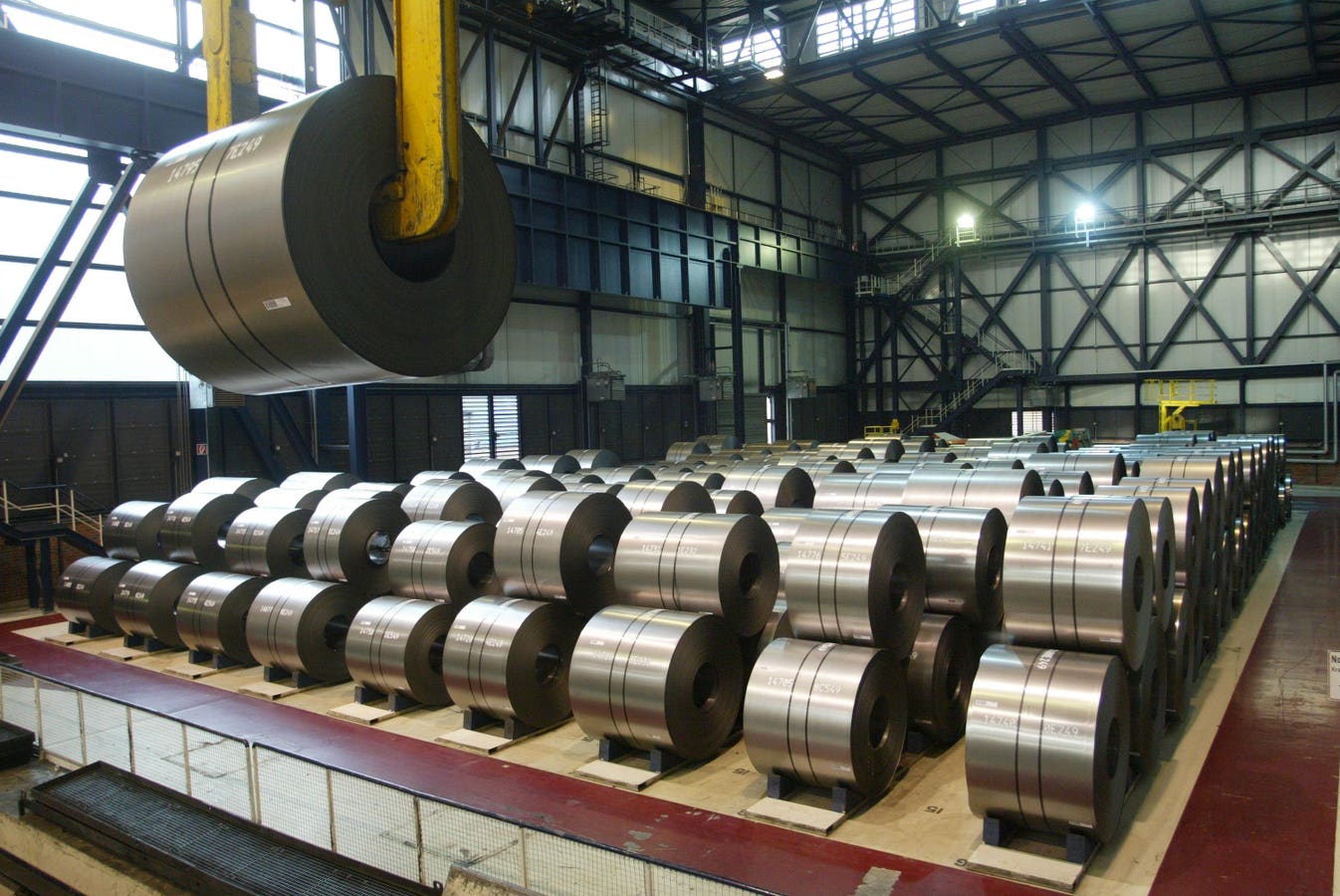In his 1865 book ‘The Coal Question’, economist William Stanley Jevons postulated that the invention of the steam engine, the great productivity leap of the 19th century, would not simply lead to a more efficient and stable demand for the mining of coal. Rather, he suggested (correctly) that whenever a step-up in productivity growth is achieved, it leads to a spectacular increase in the general demand for energy, as society seeks to leverage this great new thing to raise its standard of living.
Today, as we approach several exciting technological leaps, whether with artificial intelligence or clean energy, I expect to see an increase in demand for a key building block behind those leaps: steel. Nucor Corporation (NUE), the largest and most diversified steel producer in the U.S., is this week’s Long Idea.
NUE presents quality risk/reward given the company’s:
- position as the leading domestic producer of steel amid rising demand,
- strong revenue growth and improving profitability,
- consistent cash flow generation,
- growing dividends and share repurchases and
- attractive valuation.
Steel Drives Clean Energy Transition
Steel plays a crucial role in the development of renewable energy infrastructure and is the most recycled material in the world. The United Nations suggests that global renewable energy capacity needs to be doubled by 2030, which, in turn, will drive long-term demand for steel. The International Energy Agency (IEA) articulates this symbiotic relationship by stating, “steel needs energy and the energy system needs steel.”
According to Nucor’s research, the clean energy transition in the U.S. alone is expected to add 2-3 Mtpa (million tons per annum) in steel demand. Figure 1 shows the expected growth in wind and solar installations and the resulting increase in steel demand in millions of tons per year, after accounting for the Inflation Reduction Act (IRA).
Figure 1: Green Energy Drives Increased Steel Demand
Expanding to Meet Growing Demand
The IEA anticipates a significant increase in steel demand over the next quarter-century and beyond.
Nucor Corporation is actively investing in steel mill projects to boost production capacity and meet the growing demand for steel. The company’s Nucor Steel Gallatin plant produced 365,000 tons in 1Q23 and is on track to reach its full run-rate production of 2.8 million tons per year by the end of 2Q23. This ramp-up, along with expected throughput and margins, positions Gallatin for profitability in 2Q23.
Additionally, Nucor Steel West Virginia is making progress in its construction phase, which is expected to last approximately two years after the receipt of all required permits. Although it is still awaiting one federal permit, the project’s updated capital expenditure budget of $3.1B has already been announced.
In the steel plate division, Nucor Steel Brandenburg has continued to increase the production of its caster and rolling mill throughout 1Q23. Boasting the largest caster in the western hemisphere, the plant is now targeting the production of 500,000 tons in 2023. The Brandenburg plant is anticipated to turn profitable by 4Q23.
According to management, these projects are the result of a $14 billion capital campaign that aims to double Nucor’s earnings power from pre-pandemic levels.
Fiscal Trifecta to Further Drive Demand for Steel
Three key U.S. federal policy initiatives will also increase demand for steel: the Infrastructure Investment and Jobs Act (IIJA), the Inflation Reduction Act (IRA), and the Creating Helpful Incentives for the Production of Semiconductors (CHIPS) Act.
- The IIJA allocates $550 billion in new funding towards transportation and core infrastructure projects. This legislation is estimated to generate an incremental annual steel demand of 3-5 million tons per annum (Mtpa). The initial wave of bridge projects has already commenced, and the act stipulates transportation funding through 2026.
- The IRA has introduced $370 billion in clean energy tax incentives, another potent driver of steel demand. The Biden administration’s target of achieving 30 gigawatts of U.S. offshore wind capacity by 2030 requires extensive infrastructure, which contributes an expected 2-3 Mtpa of additional steel demand. This demand aligns with the greenhouse gas reduction goals set by most large utilities, which reinforces the path to net zero.
- The CHIPS Act, aimed at reshoring U.S. manufacturing, brings an additional source of demand. With its allocation of $55 billion, the act is projected to fund over 30 advanced manufacturing projects over the next decade and create an estimated 0.5 Mtpa in steel demand.
These federal initiatives, backed by nearly $975 billion in funding, are projected to generate approximately 5-8 Mtpa in incremental annual steel demand over the coming decade. In an interesting second-order effect, and in allusion to William Jevons’ theory in The Coal Question, management says of the CHIPS Act and the resulting semiconductor facilities:
“they’re going to provide the chips to our end-use Tier 1 automotive customers, our HVAC customers and our heavy equipment customers that are all waiting for those and we’re ready to grow at that demand.”
Technological improvements lead to increased demand, and the cycle feeds on itself.
Fiscal Trifecta Diminishes Customer Concentration Risk
Nucor is the largest steel producer in the U.S., and it also sells to customers located in Canada and Mexico. This sales mix creates could pose some customer concentration risk given that Asia is projected to be the largest user of steel products in the world, followed by Europe and then, North America. However, any risk of Nucor missing out on demand in other parts of the world is not only reflected in its stock price (and then some) but also diminished by the fiscal policy initiatives noted above.
Cyclicality More Than Priced In
The cyclical nature of the metals industry cannot be ignored when discussing a company such as Nucor. Steel demand generally increases during economic booms and falls during recessions. However, Nucor, through its low-cost production, and flexibility to adjust production to efficiently match demand, has proven its ability to remain profitable throughout economic cycles.
Since 1998, Nucor has generated positive NOPAT and return on invested capital (ROIC) in all but one year, 2009.
Despite the consistently profitable business operation, Nucor is priced as if its profits will permanently decline by 50% from current levels, an expectation that does not match the reality of management’s projections or third-party analysis of the steel industry.
Attractive Dividend and Repurchase Yield
Over the last three fiscal years, Nucor has returned approximately half of net earnings to shareholders via dividends and share repurchases. In fact, 1Q23’s dividend payment was Nucor’s 200th consecutive quarterly dividend. Since 2018, the company has paid $2.6 billion (7% of current market cap) in cumulative dividends and has increased its quarterly dividend from $0.38/share in March 2018 to $0.51/share in May 2023. The company’s current dividend, when annualized, provides a 1.4% yield.
Nucor also returns capital to shareholders through share repurchases. From 2018 – 2022, the company repurchased $7.2 billion (19% of market cap) worth of stock, of which $2.8 billion was repurchased in 2022.
In May 2023 the company’s board of directors approved a $4.0 billion share repurchase plan, at the company’s discretion and with no expiration date. Should the company repurchase shares at its 2022 rate, the buybacks would provide an additional 7.4% annual yield at Nucor’s current market cap. Combining share repurchases with a current dividend yield of 1.4% could give investors an 8.8% yield on their shares.
It is also important to note that Nucor’s free cash flow easily exceeds its regular dividend payments. From 2018 to 2022, Nucor generated $9.1 billion in FCF while paying $2.5 billion in dividends. See Figure 2.
Figure 2: Nucor’s Free Cash Flow Vs. Cash Dividends Paid: 2018 – TTM
Improving Fundamentals
After beating earnings estimates in 1Q23, management guided for higher earnings in 2Q23 and continues to expect firm demand for the remainder of the year. 1Q23 was the ninth consecutive quarter in which Nucor generated over $1 billion in net operating profit after tax (NOPAT). The company has generated positive NOPAT in 24 of the past 25 years (2009 being the only exception).
The company has grown revenue and NOPAT by 14% and 35% compounded annually, respectively, since 2017. The company’s NOPAT margin improved from 8% in 2017 to 18% in the trailing twelve months (TTM), while invested capital turns remained unchanged at 1.5 over the same time. Rising NOPAT margins drive the company’s return on invested capital from 11% in 2017 to 27% in the TTM. See Figure 3.
Figure 3: Nucor’s Revenue and NOPAT: 2013 – TTM
Strong and Rising Free Cash Flows
Per Figure 4, Nucor has generated a cumulative $9.9 billion in FCF since 2017, which represents 21% of its enterprise value. Nucor’s large and rising free cash flow (FCF) shows the company’s ability to expand capacity while running a very profitable business.
Figure 4: Nucor’s Free Cash Flow, 2017 – TTM
Superior Profitability
Not only does Nucor operate in an industry facing rising demand, but the company also manufactures steel at a lower cost than its competitors. Nucor utilizes scrap steel in its electric arc furnaces (EAF), which lowers overall costs and produces an end product with a lower carbon footprint. Note that EAF technology is uneconomical for other large competitors (such as Vale), due to a lack of availability of scrap steel and an abundance of iron ore (which favors traditional steelmaking methods).
Accordingly, Nucor boasts superior profitability compared to its publicly-traded peers. The company’s ROIC of 27% is second only to Steel Dynamics, Inc. (STLD) in a peer group which includes United States Steel Corp (X), ArcelorMittal (MT), and other large materials companies. See Figure 5.
Figure 5: Nucor’s Profitability Vs. Peers: TTM
Shares Have 30% Upside at Current Price
At its current price of $150/share, Nucor has a price-to-economic book value (PEBV) ratio of 0.5, which means the market expects profits to permanently fall 50% from current levels. Below, I use my reverse discounted cash flow (DCF) model to further quantify how low the expectations baked into Nucor’s stock price are. I also present the upside potential in the stock if the company grows NOPAT below historical growth rates.
DCF Scenario 1: to Justify the Current Stock Price
I assume Nucor’s:
- NOPAT margin falls to 10.7% (from 18% in the TTM and five-year average of 13%), and
- revenue falls at consensus rates in 2023 and 2024, and never grows again through 2032 (compared to 14% compound annual growth since 2017).
In this scenario, Nucor’s NOPAT would fall 8% compounded annually through 2032 and the stock would be worth $150/share today – equal to the current price. For reference, Nucor has grown NOPAT by 35% compounded annually since 2017 and 18% compounded annually since 2002.
DCF Scenario 2: Shares Have 31%+ Upside Even Assuming Large Drop in Profits
If I assume Nucor’s:
- NOPAT margin falls to 12% (still below its 5-year average of 13%) from 2023 to 2032,
- revenue grows at consensus estimates in 2023 (-14%) and 2024 (-6%), and
- revenue grows 3% compounded annually from 2025 to 2032 (versus 7% compounded annually since 2012), then
NUE would be worth at least $196/share today – a 31% upside to the current price. In this scenario, Nucor’s NOPAT still falls 5% compounded annually over the next decade and, in 2032, is just over two-thirds its 2022 level.
Should Nucor grow profits more in line with historical levels, the stock has even more upside. Figure 6 compares Nucor’s historical NOPAT to the NOPAT implied in each of the above DCF scenarios.
Figure 6: Nucor’s Historical and Implied NOPAT: DCF Valuation Scenarios
Sustainable Competitive Advantages Will Drive Shareholder Value Creation
Here’s a summary of why I think the moat around Nucor’s business will enable it to continue to generate higher NOPAT than the current market valuation implies.
- unique position as the leading producer of steel in the U.S.,
- more efficient cost structure based on EAF technology,
- strong revenue and margin growth and
- expanding capacity to meet rising demand.
What Noise Traders Miss with Nucor
These days, fewer investors focus on finding quality capital allocators with shareholder-aligned corporate governance. Due to the proliferation of noise traders, the focus is on short-term technical trading trends while more reliable fundamental research is overlooked. Here’s a quick summary of what noise traders are missing:
- the clean energy transition drives a significant increase in the demand for steel,
- Nucor’s market leadership positions it to grow market share amid rising demand and
- strong public support for infrastructure spending also drives long-term demand for steel.
Earnings Beats Could Send Shares Higher
Nucor has beaten earnings estimates in eight of the past 10 quarters and doing so again could send shares higher. Beyond earnings beats, the market’s recognition of the significance of steel demand in the clean energy transition, as well as the avalanche of public funding that is coming online to fund steel-intensive projects, could send shares higher as well.
Executive Compensation Is Aligned With Shareholders’ Interests
Investors should favor companies with executive compensation plans that directly align executives’ interests with shareholders’ interests. Quality corporate governance holds executives accountable to shareholders by incentivizing them to allocate capital prudently.
In addition to base salary, Nucor’s executives receive annual incentives that are awarded in part based on return on average invested capital, a similar metric to ROIC.
Tying executive compensation to ROIC, or a similar measure, ensures that executives’ interests are more aligned with shareholders’ interests as there is a strong correlation between improving ROIC and increasing shareholder value.
Given management has a real interest in creating shareholder value, it should come as no surprise that Nucor has grown economic earnings, the true cash flows of the business, from $611 million in 2017 to $5 billion in the TTM.
Insider Trading and Short Interest Trends
Over the past 12 months, insiders have purchased 407,849 shares and have sold 180,218 shares for a net effect of 227,631 shares bought. These sales represent less than 1% of shares outstanding.
There are currently 6.0 million shares sold short, which equates to 3% of shares outstanding and four days to cover. The lack of significant short interest reveals not many are willing to take a stake against this highly profitable company.
Attractive Funds That Hold NUE
The following funds receive an attractive-or-better rating and allocate significantly to NUE:
- Van Eck Steel ETF (SLX) – 6.9% allocation and very attractive rating
- iShares U.S. Basic Materials ETF (IYM) – 4.8% allocation and attractive rating
- First Trust Materials AlphaDEX Fund (FXZ) – 4.8% allocation and very attractive rating
- State Street SPDR S&P Metals & Mining ETF (XME) – 4.3% allocation and attractive rating
- State Street Materials Select Sector SPDR Fund (XLB) – 4.1% allocation and attractive rating
- Alpha Architect U.S. Quantitative Value ETF – 2.0% allocation and a very attractive rating.
Disclosure: David Trainer, Kyle Guske II, and Italo Mendonca receive no compensation to write about any specific stock, style, or theme.
Read the full article here







